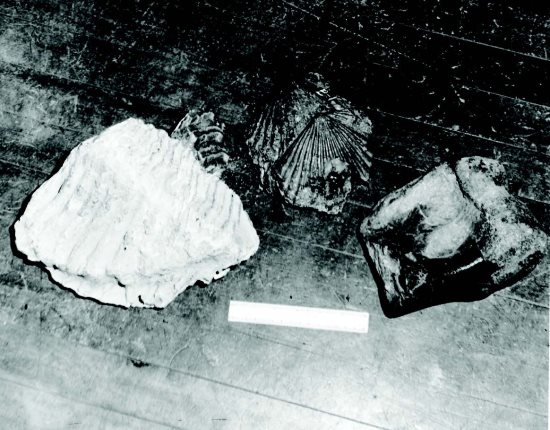| | Published February 20th, 2019
| Moraga under water?
| | | By Vera Kochan |  | | Photo Bob Yost From left, hip bone of mastodon, scallop shell, lower molar of mastodon compared to a six-inch ruler. Fossils discovered in Bollinger Canyon cliffs. |
If you think that your yard suffered water damage during the last rainstorm, try to imagine it completely under water as it was over 15 million years ago.
 Prior to that, the area now known as Contra Costa County was under the Pacific Ocean. About 40 million years ago, the land mass to the west of Moraga, the Berkeley Hills, began to rise, bringing out of the sea a range of coastal mountains.
Prior to that, the area now known as Contra Costa County was under the Pacific Ocean. About 40 million years ago, the land mass to the west of Moraga, the Berkeley Hills, began to rise, bringing out of the sea a range of coastal mountains.
 About 30 million years later, the great inland sea began to uplift and drain. At one point in time, Mt. Diablo was an island. Subsequently, the Las Trampas Ridge began to rise and form. In doing so, it created a basin of water that was left behind while much of it flowed back into the Pacific. This enclosed basin included what is known today as the Moraga/Orinda area.
About 30 million years later, the great inland sea began to uplift and drain. At one point in time, Mt. Diablo was an island. Subsequently, the Las Trampas Ridge began to rise and form. In doing so, it created a basin of water that was left behind while much of it flowed back into the Pacific. This enclosed basin included what is known today as the Moraga/Orinda area.
 The basin eventually became a freshwater lake, where to this day geologists can still uncover fossils of shellfish.
The basin eventually became a freshwater lake, where to this day geologists can still uncover fossils of shellfish.
 According to an article by Moraga historian Gladys Shally, "The oldest known fossils in the Bay Area are microscopic animals, known as radiolaria, and are found in marine deposits." While drilling for an oil well in Lafayette brought up rock specimens rather than oil, the specimens contained radiolaria with an age date "estimated at 40 to 50 million years old."
According to an article by Moraga historian Gladys Shally, "The oldest known fossils in the Bay Area are microscopic animals, known as radiolaria, and are found in marine deposits." While drilling for an oil well in Lafayette brought up rock specimens rather than oil, the specimens contained radiolaria with an age date "estimated at 40 to 50 million years old."
 Shally continues, "Ancient sediments found in the Burton area, in Bollinger Canyon and Las Trampas Ridge, contain fossils of clams, snails, scallops, sand dollars etc. Even a whale vertebra was found near Rheem."
Shally continues, "Ancient sediments found in the Burton area, in Bollinger Canyon and Las Trampas Ridge, contain fossils of clams, snails, scallops, sand dollars etc. Even a whale vertebra was found near Rheem."
 One of the best fossil beds still lies in the Moraga Bluffs where, due to volcanic action, wave ripples that once lay along the ancient lake's perimeter, have been upended to form sandstone cliffs or walls.
One of the best fossil beds still lies in the Moraga Bluffs where, due to volcanic action, wave ripples that once lay along the ancient lake's perimeter, have been upended to form sandstone cliffs or walls.
 So, the next time it rains three inches in 24 hours remember, it could've been worse.
So, the next time it rains three inches in 24 hours remember, it could've been worse. |
| | | | | | | | | | | | |



